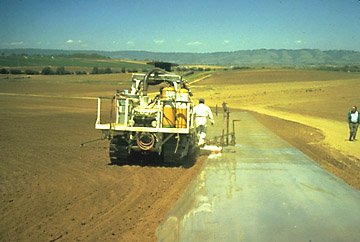Uses of Methyl Bromide in Agriculture
Methyl bromide is a widely used fumigant in U.S. agriculture and is one of the five most used pesticides in the U.S. Between 25 and 27,000 metric tons of methyl bromide are applied annually. More than 75% of the use of methyl bromide is for preplant fumigation of soil (Figure 1). In addition, methyl bromide is used for post-harvest treatment of nonperishables (13%) and perishables (8.6%) and for quarantine purposes (<1%). The compound also occurs as an intermediate in chemical manufacturing and is used as a medical sterilant. Methyl bromide is an effective herbicide, nematicide, insecticide, and fungicide and has been used commercially in the U.S. for soil fumigation and quarantine purposes for most of the 20th century.

Figure 1. Commercial fumigation of agricultural soils with methyl bromide.
Methyl Bromide and Ozone Depletion
Considerable evidence has accumulated that methyl bromide is a potent ozone depletor and the compound is scheduled to be phased out in the U.S. by 2001 under the Clean Air Act (Figure 2). The use of methyl bromide was a critical factor in dramatic changes in crop production systems in California, Florida, North Carolina, and elsewhere. Crop rotations were once standard methods of pest management before widespread use of soil fumigation and plastic mulching. Production of crops such as strawberries and fresh market tomatoes have become highly dependent on methyl bromide use leading to reductions in crop rotations and reductions in diversification in production practices. The economic viability of specific crops in Florida, California, North Carolina, and other states could be impacted by the loss of use of this compound if no alternatives are available.
Figure 2. History of the Antarctic ozone hole from 1970 to 1993.

Figure 2. History of the Antarctic ozone hole from 1970 to 1993.
Implications to Control of Plant Diseases
The pending elimination of methyl bromide use in the U.S. has stimulated a great deal of creative research that should improve our ability to manage soilborne pathogens using ecologically-based pest management strategies in the future. It is clear from most of the research conducted to date that a single alternative fumigant will not be found to replace methyl bromide. Some would argue that it is not desirable that a single new "magic bullet" fumigant be found that is as efficacious and widely applicable as methyl bromide. Use of a diversity of management practices that include less dependance on single-chemical strategies and greater use of biological and cultural management strategies will enhance grower options. On the other hand, if a single chemical method of control that is safe and efficacious could be found to replace methyl bromide, it would be rapidly adopted by growers. Fortunately, plant pathologists around the country are working earnestly to develop ecologically-based alternatives to soil fumigation. Such approaches include the use of resistant varieties, organic soil amendments, biological controls, crop rotations, soil solarization and judicious use of low-risk chemical alternatives.
Phaseout of Methyl Bromide Is Imminent
Currently, the EPA acting under The Clean Air Act has scheduled the domestic U.S. phaseout date for production and importation of methyl bromide for January 1, 2001. On September 17, 1997, at the Ninth Meeting of the Parties to the Montreal Protocol, a significant acceleration in the phaseout of the compound by other developed and developing countries was agreed upon. Developed (industrialized) countries agreed to 25% reductions in methyl bromide consumption in 1999, 50% reductions in 2001, 70% reductions in 2003, and 100% reductions in 2005. Prior to this meeting, developed countries had set a 2010 phase out date for the compound (see feature article from September 1997
Plant Disease). These reductions are based on 1991 consumption levels which were frozen in 1995. In addition, developing nations have now agreed to phaseout the compound. Prior to the September 1997 meeting of the parties, this had not been the case (see feature article from
Plant Disease). It is important to remember that developing nations only account for 18% of the worldwide use of the fumigant. Developing nations agreed to 20% reductions in consumption by 2005, and 100% reductions in consumption by 2015. These reductions are based on average 1995-98 consumption levels which will be frozen in 2002.
